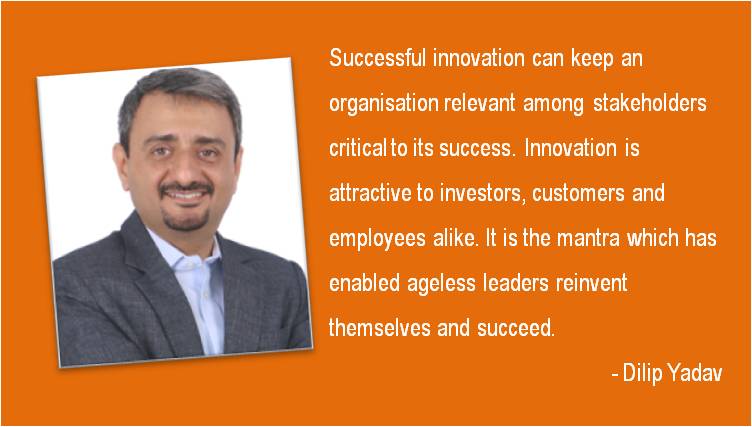“Innovation distinguishes between a leader and a follower” – Steve Jobs
Innovation has finally started to get high on the executive agenda and it is no longer a debate that the future winners are those who know how to make innovation happen. This is self-evident.
Our society is in a constant flux. A wave, nay, a shock-wave of profound, inexorable change threatens to sweep away the unprepared. Alvin Toffler described this as a ‘Future Shock’. Businesses today, survive the paroxysm of debilitating change by preparing for the now as much as shoring up for the future. Innovation is usually the insurance of triumphant longevity. There are cases abound of how the new and golden age of globalised entrepreneur-led markets, and techno-fiscal prudence is churning the old staid corporate hierarchy and throwing up new Davids and Abhimanyus to stand their own against the Goliaths and Pitamahs of old.
According to a KPMG UK 2017 CEO Report, 70% of CEOs consider opening dialogues with new entrants and start-ups to better understand new technologies, disruptions and opportunities in their marketplace, as they are twice as likely to see recent market entrants rather than existing competitors, as a more disruptive threat to their business model.
The primary responsibility for a business head is to make the organisation win. A leader of the company is the one who is faced with the most daunting responsibility that the company should deliver continuous success. In fact, to my mind, that is the only job they have. Everything else, be it marketing, finance, HR, technology etc., has functional ownership silos set and cast in a finite, structured setup, each with their defined goals. It is the leader who must string the net outcome of these functions together into a visible success.
Successful innovation can keep an organisation relevant among stakeholders critical to its success. Innovation is attractive to investors, customers, and employees alike. Innovation is that mantra which has enabled ageless leaders reinvent themselves and succeed. P&G and Salesforce are examples of companies that developed an excellent approach to innovation which helped them stay ahead. The down side of not being able to innovate has horror stories of once powerful brands like Kodak and Nokia vanishing from the market.
For investors, great innovation is key. This is evident from the megabucks readily available today to the new-age enterprises and startups. Uber, Tesla, Airbnb and closer home, Flipkart, Swiggy, Zomato, Ola, form the list of companies attracting investor confidence, which is actually a list of outstanding innovation in great action. Backed by investor confidence, Tesla is more likely to acquire a legacy automobile giant, rather than to have to battle one in contrast to prediction by theorists that its “future holds either acquisition by a much larger incumbent or a years-long and hard-fought battle for market significance”.
For customers, innovation in products and services is what attracts them as vindicated time and again by the success of brands which brought new thinking to the market. Airbnb represents the modern customer experience, providing customers a seamless journey via its technology. In India, Indigo is a good example of a company which rapidly moved from being a start-up to India’s largest airline by passenger traffic in record time backed by innovation in service and communication.
Millennials and forward-looking employees don’t really wish to work for organisations with old thinking. They embrace, breathe, and breed innovation. They are critical for building a culture of innovation in an organisation.
Who else but the leader?
Another reason for the CEOs’ and business leaders’ focus on innovation-led growth is that there is no one else who can do the job completely. Take the example of Wipro and ITC. These organisations are excellent cases of innovation from the top. Their leadership recognised that staying relevant, or future-proofing their businesses, was possible only through diversification. Wipro, originally an oil and chemicals company, innovated to become an IT giant, and has managed to remain in the game through product, process, industry, and tech innovations. ITC’s diversification strategy laid down two decades ago enabled the company to transform itself into a multi-business, multi-dimensional conglomerate, building leadership position in 13 businesses spanning packaged foods, hotels, paperboards & paper, education and stationery and FMCG.
To be at the top of the game for a business leader is as much a challenge as it is a high. The creative core of innovation demands self-conviction, commitment and ability to communicate the vision. The business head knows and understands the complete picture as no one else in the organisation does. Jeff Bezos of Amazon appeared to be going against the grain many a time. His radical approach shocked and scared a lot of people along the way. But as a visionary, he knew the risks, measured his options, and was able to follow through on his long-term plans as only a leader could.
Leadership through effective communication
There is one more critical ingredient here and that is communication. A fantastic business innovation could fail just because it was poorly marketed—to investors, employees, partners, customers, board members, etc. Hence, innovative action plus effective communication of this innovation, both are equally and indispensably critical for an organisation’s success. A first-mover advantage, for instance, can be easily lost in the absence of effective story-telling and enduring audience-oriented narrative, both at the leadership and the executing level.
The success of Apple under the leadership of Steve Jobs was built as much through focusing on those aspects of the products which communicated better with the users, as well as by creating disruptive launch events which quickly caught the fancy of the markets.
When it comes to leadership communication and transmitting the CEO’s vision to relevant audience, the job of the best communicator is akin to aiding and completing the innovation process. This inextricable involvement will determine the direction and tenor of the innovation program taking it to its logical fruition. As Jack Welch said so well, “Good business leaders create a vision, articulate the vision, passionately own the vision, and relentlessly drive it to completion.”
For more conversations around Innovation (if you are an in-house communications professional), attend the Innovation First Communication Conclave in Gurgaon on Wednesday, March 14th, 2018.
The views expressed here are that of the author and do not necessarily reflect that of Reputation Today.



Be the first to comment on "Why is Innovation uppermost in the minds of Business Leaders today?"